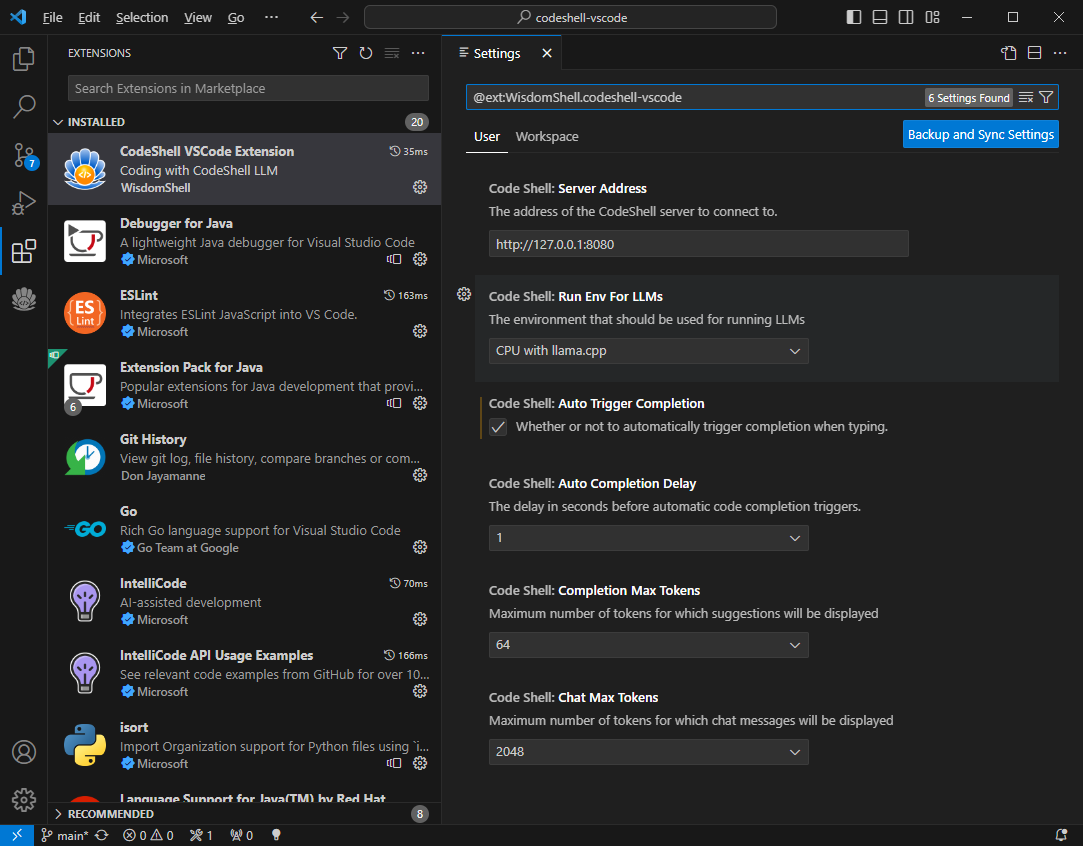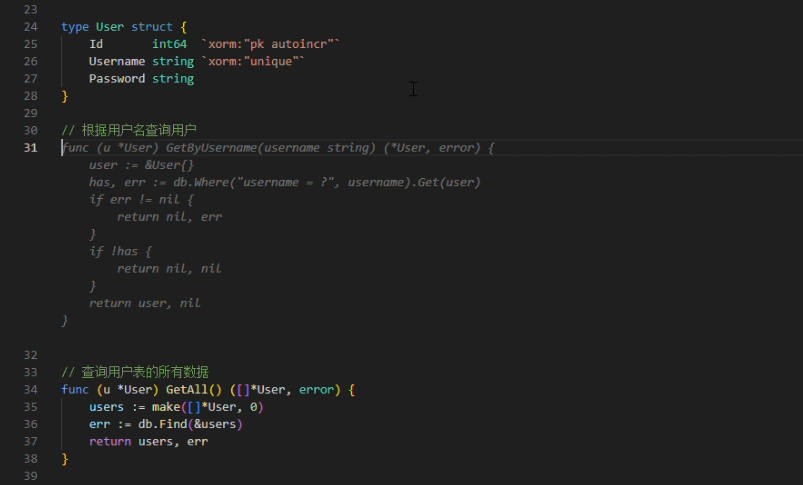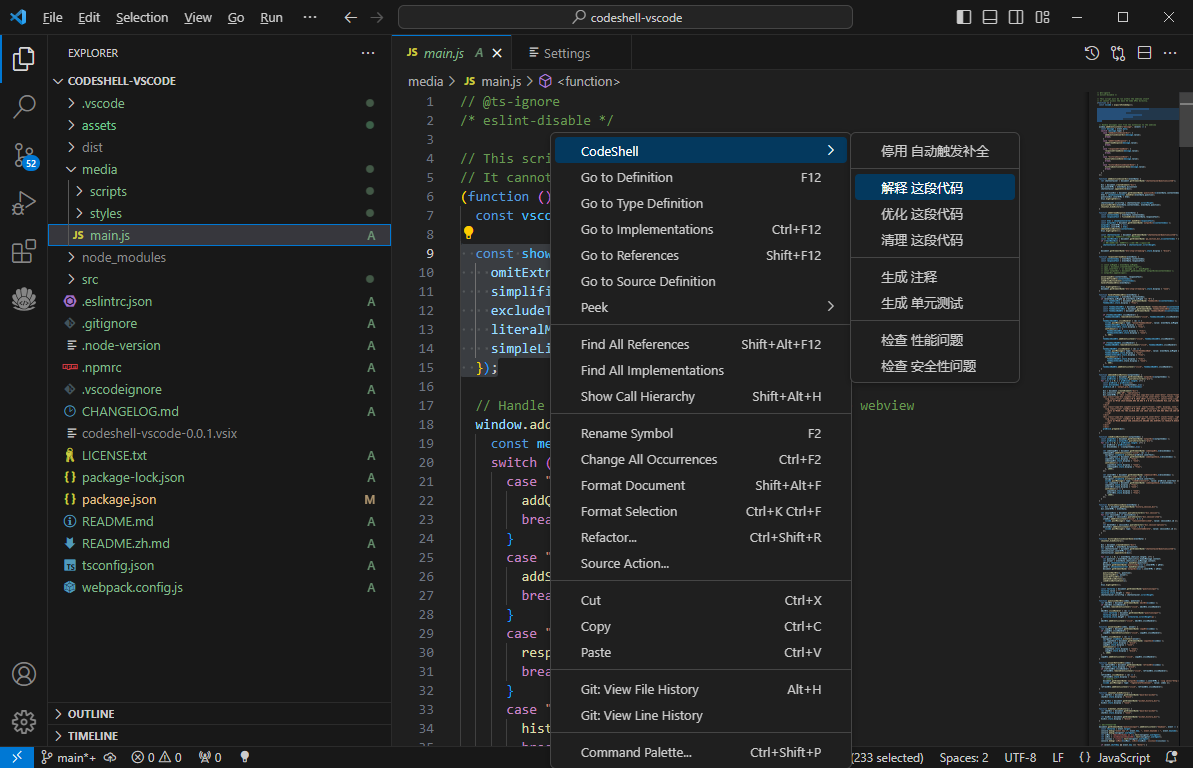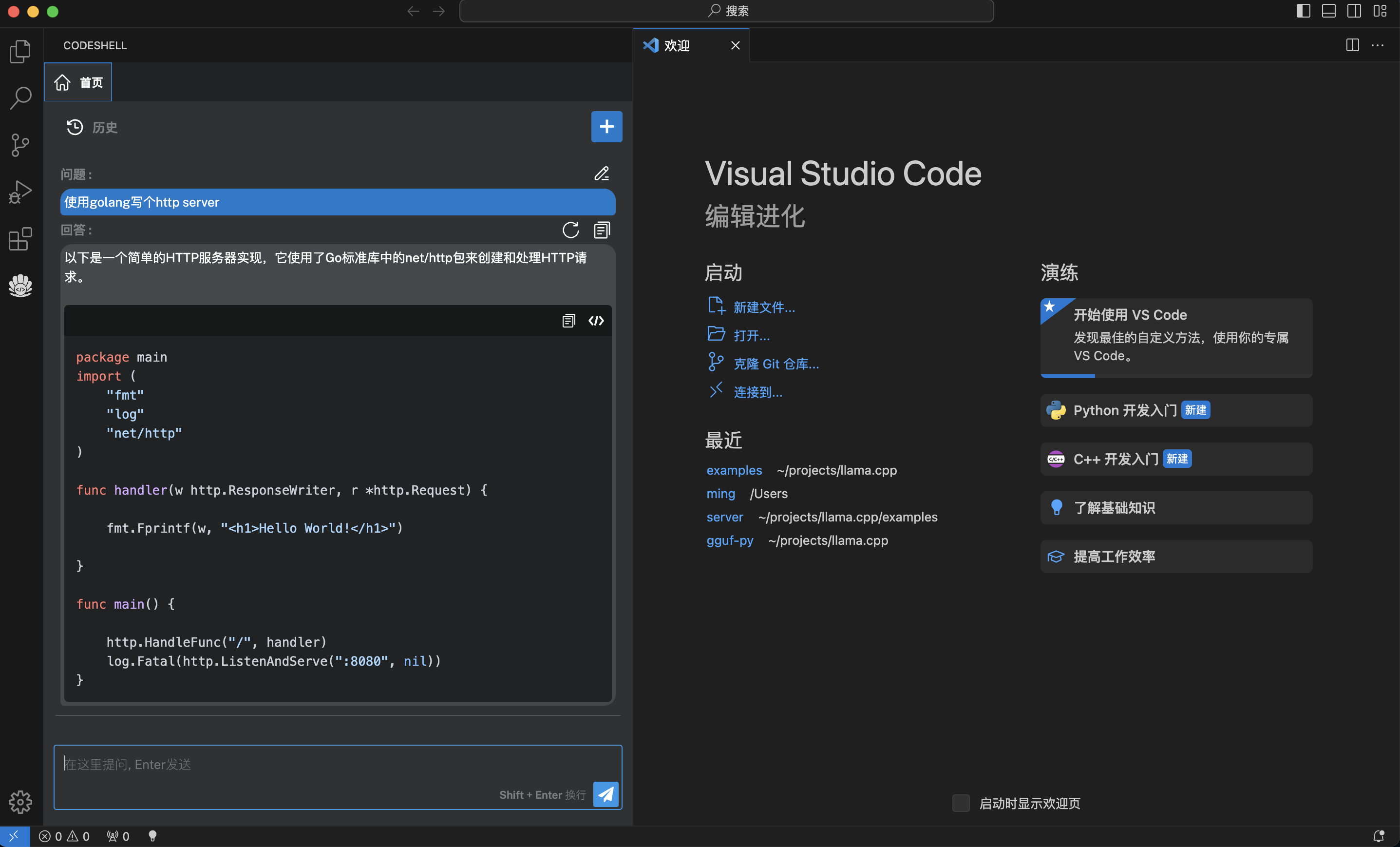The codeshell-vscode project is an open-source plugin developed based on the CodeShell LLM that supports Visual Studio Code. It serves as an intelligent coding assistant, offering support for various programming languages such as Python, Java, C/C++, JavaScript, Go, and more. This plugin provides features like code completion, code interpretation, code optimization, comment generation, and conversational Q&A to help developers enhance their coding efficiency in an intelligent manner.
- node version v18 and above
- Visual Studio Code version 1.68.1 and above
- The CodeShell service is running
If you want to run the package from source code, you need to execute the following command:
git clone https://github.com/WisdomShell/codeshell-vscode.git
cd codeshell-vscode
npm install
npm exec vsce packageand it will create a visx package file like: codeshell-vscode-${VERSION_NAME}.vsix。
The llama_cpp_for_codeshell project provides the 4-bit quantized model service of the CodeShell LLM, named codeshell-chat-q4_0.gguf. Here are the steps to deploy the model service:
-
Linux / Mac(Apple Silicon Devices)
git clone https://github.com/WisdomShell/llama_cpp_for_codeshell.git cd llama_cpp_for_codeshell makeOn macOS, Metal is enabled by default, which allows loading the model onto the GPU for significant performance improvements.
-
Mac(Non Apple Silicon Devices)
git clone https://github.com/WisdomShell/llama_cpp_for_codeshell.git cd llama_cpp_for_codeshell LLAMA_NO_METAL=1 makeFor Mac users with non-Apple Silicon chips, you can disable Metal builds during compilation using the CMake options
LLAMA_NO_METAL=1orLLAMA_METAL=OFFto ensure the model runs properly. -
Windows
You have the option to compile the code using the Linux approach within the Windows Subsystem for Linux or you can follow the instructions provided in the llama.cpp repository. Another option is to configure w64devkit and then proceed with the Linux compilation method.
On the Hugging Face Hub, we provide three different models: CodeShell-7B, CodeShell-7B-Chat, and CodeShell-7B-Chat-int4. Below are the steps to download these models.
- To perform inference using the CodeShell-7B-Chat-int4 model, download the model to your local machine and place it in the path of the
llama_cpp_for_codeshell/modelsfolder as indicated in the code above.
git clone https://huggingface.co/WisdomShell/CodeShell-7B-Chat-int4/blob/main/codeshell-chat-q4_0.gguf
- For performing inference using CodeShell-7B and CodeShell-7B-Chat models, after placing the models in a local folder, you can utilize TGI (Text Generation Inference) to load these local models and initiate the model service.
- The
CodeShell-7B-Chat-int4model can be served as an API using theservercommand within thellama_cpp_for_codeshellproject.
./server -m ./models/codeshell-chat-q4_0.gguf --host 127.0.0.1 --port 8080Note: In cases where Metal is enabled during compilation, if you encounter runtime exceptions, you can explicitly disable Metal GPU inference by adding the -ngl 0 parameter in the command line to ensure the proper functioning of the model.
- CodeShell-7B and CodeShell-7B-Chat models, loading local models with TGI and starting the model service.
For users wishing to use NVIDIA GPUs for inference, the text-generation-inference project can be used to deploy the CodeShell Large Model. Below are the steps to deploy the model service:
After downloading the model from the Hugging Face Hub to your local machine, place the model under the path of the $HOME/models folder, and you can load the model locally.
git clone https://huggingface.co/WisdomShell/CodeShell-7B-ChatThe following command can be used for GPU-accelerated inference deployment with text-generation-inference:
docker run --gpus 'all' --shm-size 1g -p 9090:80 -v $HOME/models:/data \
--env LOG_LEVEL="info,text_generation_router=debug" \
ghcr.nju.edu.cn/huggingface/text-generation-inference:1.0.3 \
--model-id /data/CodeShell-7B-Chat --num-shard 1 \
--max-total-tokens 5000 --max-input-length 4096 \
--max-stop-sequences 12 --trust-remote-codeFor a more detailed explanation of the parameters, please refer to the text-generation-inference project documentation.
- Set the address for the CodeShell service
- Configure whether to enable automatic code completion suggestions
- Set the time delay for triggering automatic code completion suggestions
- Specify the maximum number of tokens for code completion
- Specify the maximum number of tokens for Q&A
- Configure the model runtime environment
Note: Different model runtime environments can be configured within the plugin. For the CodeShell-7B-Chat-int4 model, you can choose the CPU with llama.cpp"option in the Code Shell: Run Env For LLMs menu. However, for the CodeShell-7B and CodeShell-7B-Chat models, you should select the GPU with TGI toolkit option.
- Automatic Code Suggestions
- Keyboard Shortcut for Code Suggestions
During the coding process, code completion suggestions can automatically trigger when you pause input (configurable with the Auto Completion Delay option, set to 1-3 seconds). Alternatively, you can manually trigger code completion suggestions using the shortcut key Alt+\ (for Windows) or Option+\ (for Mac).
When the plugin provides code suggestions, the suggested content appears in gray at the editor's cursor position. You can press the Tab key to accept the suggestion or continue typing to ignore it.
- Explain/Optimize/Cleanse a Code Segment
- Generate Comments/Unit Tests for Code
- Check Code for Performance/Security Issues
In the VSCode sidebar, open the plugin's Q&A interface. Select a portion of code in the editor, right-click to access the CodeShell menu, and choose the corresponding function. The plugin will provide relevant responses in the Q&A interface.
- Support for Multi-turn Conversations
- Maintain Conversation History
- Engage in Multi-turn Dialogues Based on Previous Conversations
- Edit Questions and Rephrase Inquiries
- Request Fresh Responses for Any Question
- Interrupt During the Answering Process
Within the Q&A interface's code block, you can click the copy button to copy the code block or use the insert button to insert the code block's content at the editor's cursor location.
Apache 2.0




